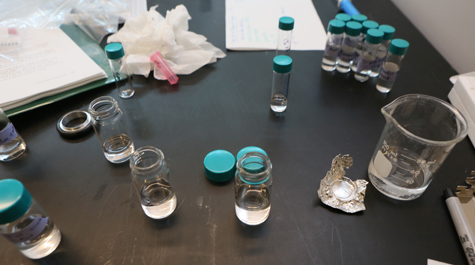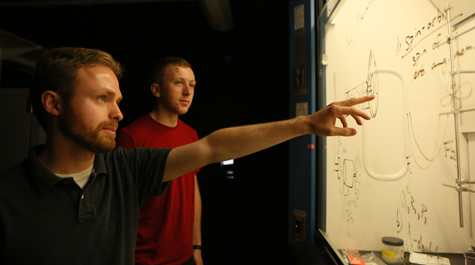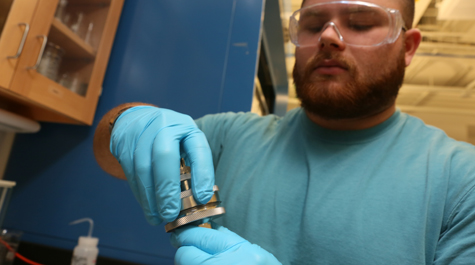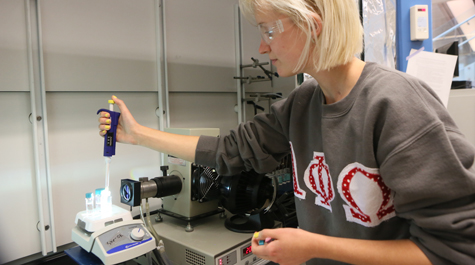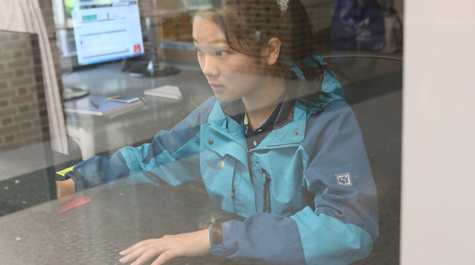How now brown cloud? W&M chemists analyze air pollution
To the uninitiated, the back corner of ISC 1233 might be mistaken for a moonshiner’s still. A series of plastic tubes corkscrew into an oversized glass jug resting inside a ventilated hood. But instead of making bootleg whiskey, Rachel O’Brien is cultivating aerosols.
“This is my aerosol farm,” O’Brien says proudly, gesturing toward the hood. “The students are making the aerosols and we’re collecting them. See, I’ve got some little guys in there.”
The little guys are actually freshly minted versions of highly prevalent components of Earth’s atmosphere. Aerosols are created when fine solid particles or liquid droplets are suspended in air or another gas. Dust, haze and smoke are all examples of aerosols. They play a vital role in influencing air quality and the Earth’s climate.
This summer, O’Brien, assistant professor of chemistry at William & Mary, is teaming up with Nathan Kidwell, also an assistant professor of chemistry. The two chemists have set their sights on brown carbon, a class of organic molecules that primarily result from fossil fuel emissions and biomass burning.
Brown carbon absorbs visible sunlight, which has an overall warming effect on the atmosphere. In fact, brown carbon absorbs such a high level of visible radiation it’s classified as a greenhouse gas.
“They’re like atmospheric sunscreen molecules,” Kidwell said. “They absorb light and can have warming implications, but they can also impact the atmosphere’s chemistry.”
To figure out exactly how brown carbon impacts the atmosphere’s chemistry, Kidwell and O’Brien plan to use the exact same brown carbon samples and examine the molecules in both the gas and condensed phase to model what happens in the wild. The duo recently received a grant from the Jeffress Memorial Trust, which supports interdisciplinary projects at Virginia research institutions.
The ultimate goal is to be able to show how the pollutant breaks apart with sunlight, as both a gas and a cloud droplet. Meeting that goal requires a sizeable group of dedicated students. Kidwell’s student researchers are Naa-Kwarley Quartey ’20, Sarah Chen ‘20, David Hood ’21 and master’s candidate K. Jacob Blackshaw. O’Brien’s student researchers are Lydia Dolvin ’20, Michael Ambrose ’19, William Perrine ‘19, Corey Thrasher ’21, Jacob Shusterman ’19 and master’s candidate Emma Walhout.
The students in O’Brien’s lab are spending the summer creating aerosols, which they will extract and mix with a combination of brown carbon molecules and cloud water. The goal is to make and study a synthetic version of real-world dirty clouds.
“A lot of brown carbon comes from pollutants, so it’s coming from combustion and reactions that occur in cities,” O’Brien said. “What we don’t understand is the fate of it, the lifetime it has in the atmosphere. In basic terms, we want to know how fast these things are destroyed by sunlight and what happens when they’re destroyed.”
Kidwell’s lab will be using the same brown carbon samples to study how the molecules break down when they are exposed to sunlight. They are also working to understand the fundamental properties of brown carbon chromophores, which give rise to the enhanced light-absorption properties of aerosols, he explained.
Their toolkit involves a series of lasers that are tuned to mimic the exact frequencies emitted by the sun. To get the highest accuracy possible, they zap samples in the gas phase.
“We have these molecules and we know that they decompose in the atmosphere,” Kidwell said. “When they absorb visible light, something happens. They can break bonds to make new products -- and those products can go on to do further chemistry. What we’re doing is effectively mapping the routes of how these molecules break apart.”
The molecules break apart differently depending on what phase they are in. When sunlight hits brown carbon in the gas phase, the molecules absorb the solar radiation and form radicals, molecules with an unpaired electron.
Radicals are highly reactive, as they look to pair off or lose their extra electron. That electron scavenger hunt leads radicals to further oxidize other organic molecules in the atmosphere and create a cascade of chemical reactions.
“Hydroxyl radical is a big one we’re watching for,” said Kidwell. The molecule consists of one hydrogen and one oxygen atom and is one of our planet’s most reactive molecules. In fact, it is commonly referred to as the “atmosphere’s detergent.” “It’s so incredibly reactive that if it hits a molecule, it instantly makes a chemical reaction.”
There are plenty of other radicals on Kidwell’s radar. He recently received funding from the American Chemical Society Petroleum Research Fund to characterize chemical reactions involving nitric oxide radicals and ambient molecules such as oxygen.
“This chemistry is important to those modeling atmospheric and combustion processes,” he said.
While brown carbon may enter the atmosphere as a gas, it doesn’t always stay that way. Brown carbon is often dissolved into cloud water droplets, which moves it to liquid, also known as the condensed phase. This is where O’Brien comes in. She specializes in aerosols, a central component in clouds.
“Every cloud in the atmosphere, every droplet of it has an aerosol seed,” O’Brien said. “We don’t nucleate clouds in the atmosphere without the aerosols, so knowing what material forms in cloud droplets can be helpful.”
In the condensed phase, brown carbon traps sunlight and warms up, which evaporates cloud droplets and drives secondary reactions with other condensed phase organic material, O’Brien explained. Since there is very little data on brown carbon in the condensed phase, she is hesitant to make predictions about what kind of chemicals will be produced as the molecule decomposes with sunlight.
“I tell people I do synthesis, but the truth is I don’t try to control my products,” O’Brien said. “We just let it rip.”
Letting it rip has worked out well so far. O’Brien is coming up on her first year at William & Mary and recently received funding from the National Science Foundation for her work pairing aerosol measurements with satellite data. She is part of an international team of researchers working to integrate image data from space with air quality data on the ground.
“Aerosols are a major contributor to premature death worldwide,” said O’Brien. “The problem is that we don’t have measurements of how many there are, especially in locations where it’s really important to have those measurements.”
O’Brien will be analyzing air samples from all over the globe inside her lab, with the help of a newly installed Orbitrap Mass Spectrometer. The instrument traps ions and converts their signals to a mass spectrum, which provides a detailed chemical analysis of what molecules the sample contains.
Hongmin Yu, a rising junior and chemistry major, is one of O’Brien’s chief collaborators on the project. She’s spending her summer combing through the data produced by the mass spectrometer. Yu grew up in Shanghai and witnessed firsthand the effects of air pollution on the environment. When she enrolled at William & Mary, she knew she wanted to focus on atmospheric science.
“The work we’re doing here is extremely important,” Yu said. “It’s crucial not only for us, but for the next generations. What I’m doing is meaningful, not just for science, but for mankind.”














